The colors of November in my garden
Pink is not a color one usually associates with autumn, but central Texas seasons are not necessarily traditional. Many of the perennials in my garden went quiet during the recent summer from hell, and now, with cooler weather and a bit of rain (yea!) they are blooming again. This is an unknown variety of pink abutilon, which prefers cooler temperatures to unfurl its lovely Chinese lantern blossoms.
Salvia coccinea ‘Coral Nymph’ is also in full bloom again, after hunkering down through the summer. This is a cultivar of our native tropical sage, which is red.
The water lilies, on the other hand, are closing up shop for the season. ‘Colorado’ still valiantly flowers, but her colors are much paler now, more apricot than rosy pink.
‘Grapes’ gomphrena is a definite fall bloomer, saving it up all summer for an explosion of tiny, magenta flowers on long, airy stems.
A wider view, with the silver foliage of orange globemallow in the background.
Exotic love vine, also known as Spanish flag, is showing its delight over cooler weather too. This annual vine, grown from seed, struggled upward through our very hot, dry summer. Now comes the payoff.
A view into the lower garden reveals more of autumn’s handiwork. The golden thryallis (Galphimia glauca), at lower left, has been blooming for a month and shows no sign of faltering. Tough native Mexican buckeye (Ungnadia speciosa) is turning yellow as well. Carpeting the limestone slabs at their feet is purple heart (Tradescantia pallida), also in bloom. The neglected trampoline in the back corner, I’m happy to report, is going to be removed this winter.
Another look at golden thryallis
And another view of the Mexican buckeye, peeking over a potted Texas nolina and more purple heart
Mexican mint marigold (Tagetes lucida) colors up cheerily in fall.
Summer-blooming native Turk’s cap (Malvaviscus arboreus) is getting sleepy, however, and rosy fruits have replaced its twisted, red flowers. The birds get most of them—their own Thanksgiving feast.
All material © 2006-2011 by Pam Penick for Digging. Unauthorized reproduction prohibited.


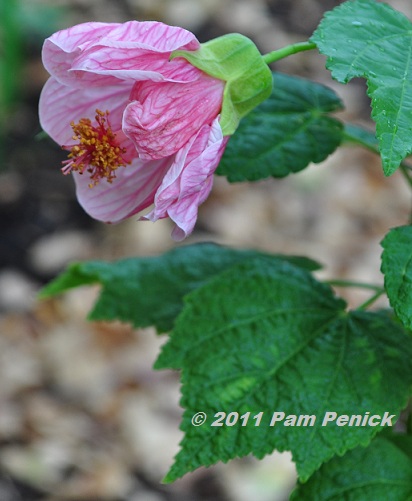
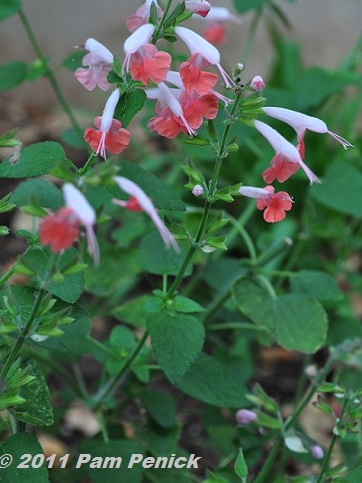

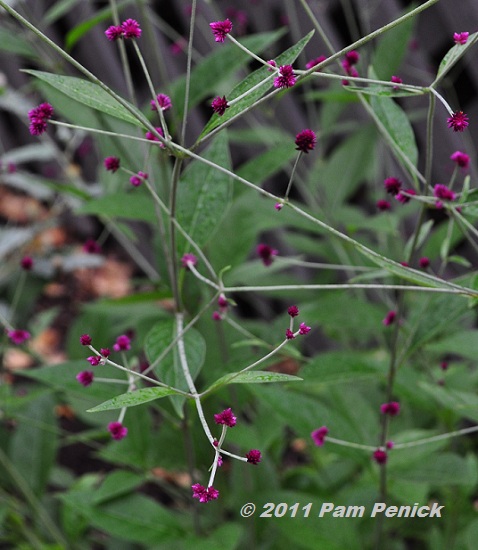
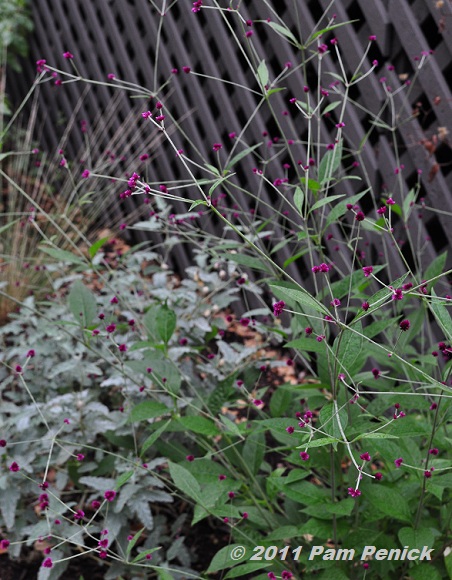
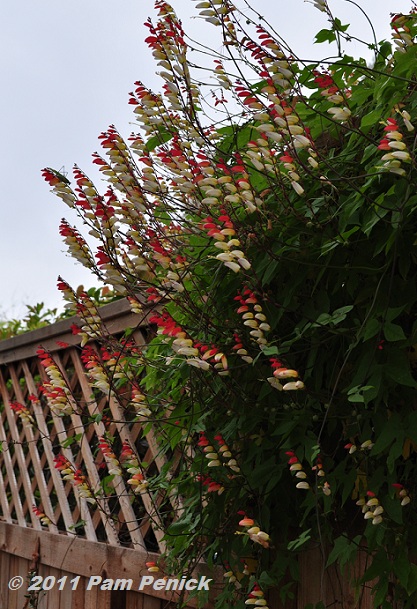
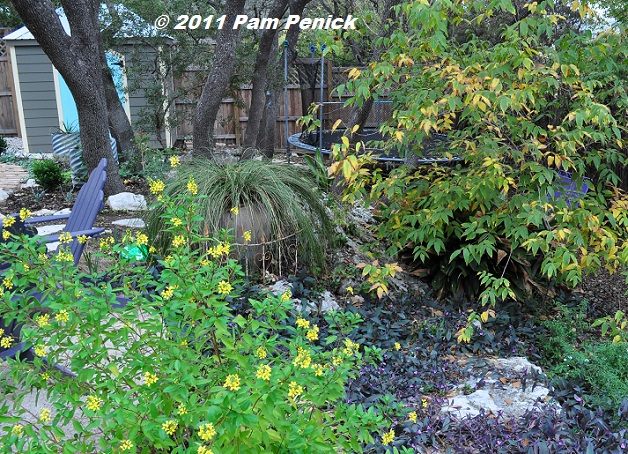
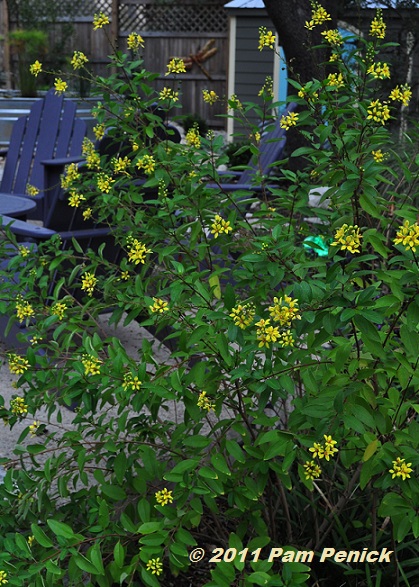
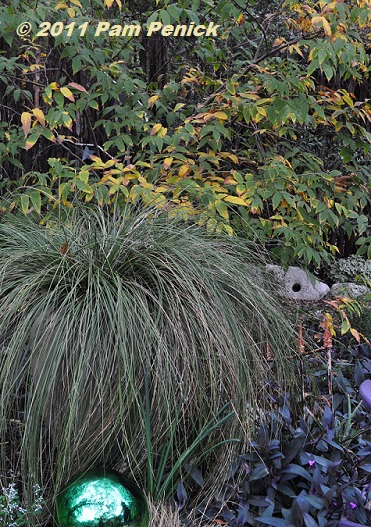
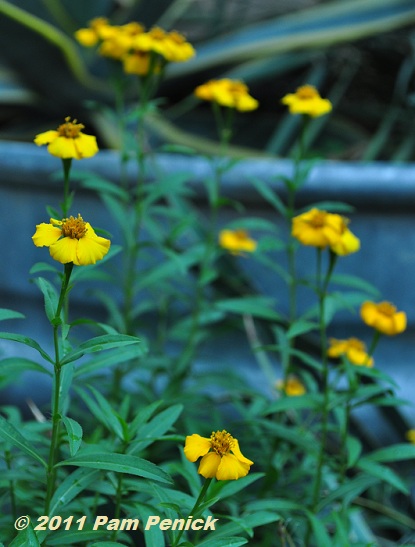
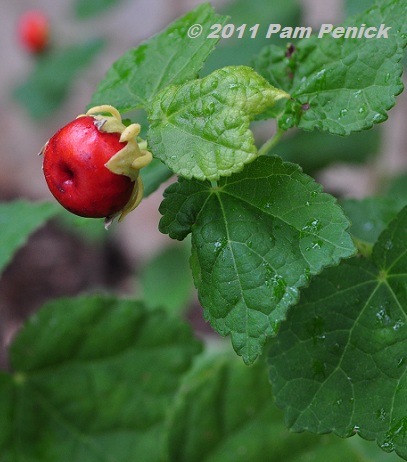
I like the kind of fall color you show, to live around…the other kind of fall color, I only like to visit. Flashy foliage, like flashy flowering, leaves one with gray and brown gloom for months…like a sugar high, then sleep. But what you show means the world is still alive. The latter is an important part of garden design!
I hear you, but I confess that I like and want it all, David. 😉 Still, this is the time of year when I’m very content to live and garden in central Texas. —Pam
You are right- you would never know it was fall with those pretty pinks. So plants in Texas will take the season when they can get it. You would never know we live only a few miles apart. I lost all my exotic love vine in the freeze along with a good deal more. Now the garden really does look like late fall. Very grateful for last nights rain, I might add. Those grape gomphrenas certainly have come into their own. Must look out for that next year. Reminds me of V bonariensis with its airy look, but of course much smaller.
It is amazing to me too how much sooner you see a freeze in your garden, Jenny, only a few miles to the south. I’ll be glad to save you some seeds from the ‘Grapes’ if you like. I’ve never grown them from seed, but perhaps it’s as easy as the standard bachelor’s buttons. Generally, ‘Grapes’ gomphrena is a perennial, but I’ve lost some during long stretches of cold weather. —Pam
Ooh, I love that Exotic Love vine. Other than the Summer From Hell, is it easy to grow? I was considering planting some form of abutilon in the spot where I decided on the Pam’s Pink Turk’s Cap. Is your abutilon more water-thirsty than other plants? As always, great photos.
Yes, it’s very easy to grow. I just scratched some seeds in the ground in early spring, and at least half of them germinated. I thinned them down to these three. The one that got hot afternoon sun struggled the most and still doesn’t look good. Two more that received a little shade from a live oak did better; they are pictured here, twined together into one mass.
Abutilon does seem fairly xeric in my garden (in dappled or afternoon shade), but I think Turk’s cap is tougher as far as winter hardiness. —Pam
Pam,
Is the Mexican Mint Marigold a perennial for you? I had a large cluster one year but lost them (zone 8a). They are a lovely fall bloomer. I have replaced that area with the dwarf pomegranate. That has interesting flowers and fruit. I am glad to see you still have some nice color. Very lovely photos.
Jeanette
Yes, it’s a perennial, Jeanette, and has always come back for me in this garden and my previous one, but that’s zone 8b. Perhaps you’re just outside its winter comfort zone? —Pam
Love all your flowers, it’s great to see them. Ours are finished now that we’ve had a hard frost. Glad you’re getting some rain there now.
Thanks, Alison, me too. We received an inch of rain early this morning. I am so grateful. —Pam
I love Spanish flag – I know it as Mina lobata. I grow it from seed some years to tuck in amongst container gardens as a ‘surprise’ for clients!
How fun! It’s a beautiful fall surprise, I bet. —Pam
To see your photo of the Exotic love vine and then read the word “annual” is quite the shock! That’s a lot of growth, especially considering the fact that it struggled over the summer.
Well, we have a long growing season, although we don’t get the extended hours of summer sunlight like you have in Oregon. I planted the seeds in late March, so that’s 8 months of growth. That’s the beauty of annuals: they have to get busy and grow quickly since they only have one season to live. —Pam
Wow, turk’s cap has berries?? I tend to stay away from annuals, but that Spanish Flag is stunning! And I love that aqua-green gazing ball you have. I’m going to try and make one from a bowling ball. Cleaned, primed, spray-painted metalic, and placed on some kind of pedastal…it just might work. 😉
I think the birds must get most of them in my garden, but aren’t those little, red fruits on the Turk’s cap cute? Like you, I don’t grow a lot of annuals (but more than I used to, now that I’ve realized how quickly they’ll fill in a bare spot, and many are quite xeric). It’s nice to try one or two new ones each year just to shake things up and add a little more color. Have fun making your own gazing ball! —Pam
You do still have a lot blooming. Like Jenny, we’ve lost a lot already to freeze here.
That Exotic Love Vine is beautiful. Did you find the seed locally?
Yes, it was from a Renee’s Garden package, which I believe I found at Barton Springs Nursery. —Pam
Pink is one of my favourite colors, and your blooms look lovely. I always wanted to try grapes gomphrena and exotic love vine. Have to get me some seeds sometime.
How is your new Caribbean garden coming along, Nicole? I bet exotic love vine would fit in beautifully. It has a tropical look. —Pam
Lovely…I just adore those Gomphrena…love those cute ephemerals!
It would work great with your grasses too, Scott. —Pam
Lovely photos, the flowers are blooming beautifully. We’re working in a community garden in Buda, Texas and growing pansies, snapdragons and violas as the weather gets cooler. We love winter color in Central Texas!
I’m grateful to be able to garden through winter here, aren’t you, Colleen? —Pam
They are truly wonderful. I really love that gomphrena!
It’s a sweet little plant, Dewi. —Pam
Hello, lovely post! I have a few pinks even still – Camellias are blooming and some roses as well as Margeurite Daisy! I have enjoyed my visit to your blog and am your newest follower!
Kathy